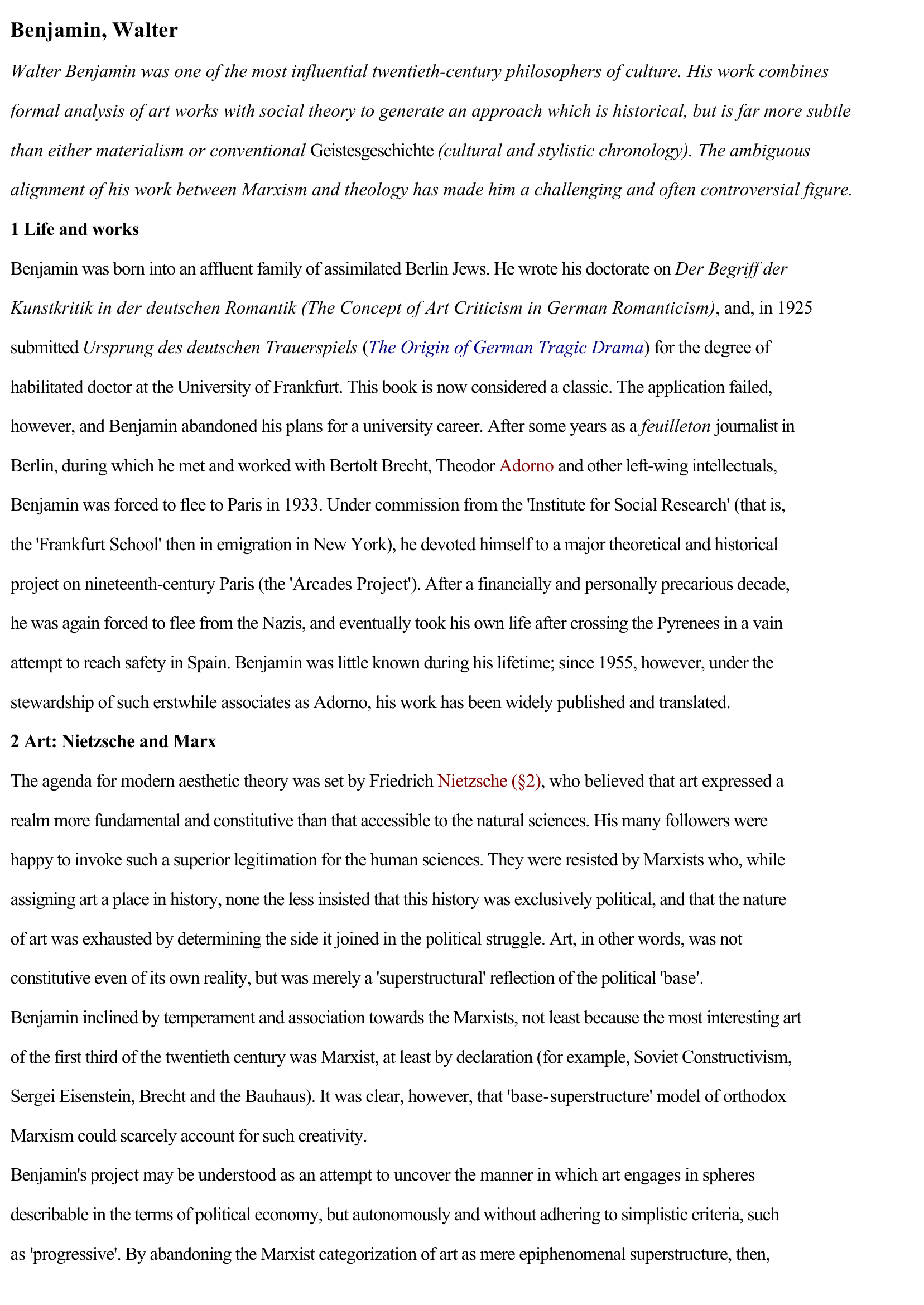Benjamin, Walter
Extrait du document
«
Benjamin, Walter
Walter Benjamin was one of the most influential twentieth-century philosophers of culture.
His work combines
formal analysis of art works with social theory to generate an approach which is historical, but is far more subtle
than either materialism or conventional Geistesgeschichte (cultural and stylistic chronology).
The ambiguous
alignment of his work between Marxism and theology has made him a challenging and often controversial figure.
1 Life and works
Benjamin was born into an affluent family of assimilated Berlin Jews.
He wrote his doctorate on Der Begriff der
Kunstkritik in der deutschen Romantik (The Concept of Art Criticism in German Romanticism), and, in 1925
submitted Ursprung des deutschen Trauerspiels (The Origin of German Tragic Drama) for the degree of
habilitated doctor at the University of Frankfurt.
This book is now considered a classic.
The application failed,
however, and Benjamin abandoned his plans for a university career.
After some years as a feuilleton journalist in
Berlin, during which he met and worked with Bertolt Brecht, Theodor Adorno and other left-wing intellectuals,
Benjamin was forced to flee to Paris in 1933.
Under commission from the 'Institute for Social Research' (that is,
the 'Frankfurt School' then in emigration in New York), he devoted himself to a major theoretical and historical
project on nineteenth-century Paris (the 'Arcades Project').
After a financially and personally precarious decade,
he was again forced to flee from the Nazis, and eventually took his own life after crossing the Pyrenees in a vain
attempt to reach safety in Spain.
Benjamin was little known during his lifetime; since 1955, however, under the
stewardship of such erstwhile associates as Adorno, his work has been widely published and translated.
2 Art: Nietzsche and Marx
The agenda for modern aesthetic theory was set by Friedrich Nietzsche (§2), who believed that art expressed a
realm more fundamental and constitutive than that accessible to the natural sciences.
His many followers were
happy to invoke such a superior legitimation for the human sciences.
They were resisted by Marxists who, while
assigning art a place in history, none the less insisted that this history was exclusively political, and that the nature
of art was exhausted by determining the side it joined in the political struggle.
Art, in other words, was not
constitutive even of its own reality, but was merely a 'superstructural' reflection of the political 'base'.
Benjamin inclined by temperament and association towards the Marxists, not least because the most interesting art
of the first third of the twentieth century was Marxist, at least by declaration (for example, Soviet Constructivism,
Sergei Eisenstein, Brecht and the Bauhaus).
It was clear, however, that 'base-superstructure' model of orthodox
Marxism could scarcely account for such creativity.
Benjamin's project may be understood as an attempt to uncover the manner in which art engages in spheres
describable in the terms of political economy, but autonomously and without adhering to simplistic criteria, such
as 'progressive'.
By abandoning the Marxist categorization of art as mere epiphenomenal superstructure, then,.
»
↓↓↓ APERÇU DU DOCUMENT ↓↓↓
Liens utiles
- Benjamin Constant a écrit : « Cette fureur de reconnaître dans les ouvrages d'imagination des individus qu'on rencontre dans le monde est pour les ouvrages un véritable fléau. Elle les dégrade, leur imprime une direction fausse, détruit leur intérêt et a
- Benjamin Constant a dit : « L’unique garantie des citoyens contre l’arbitraire, c’est la publicité. » Expliquez et critiquez cette citation.

































